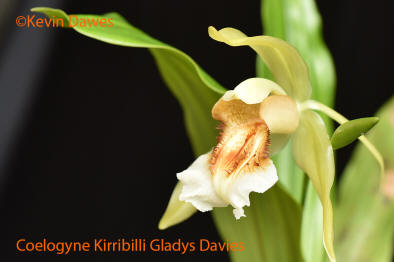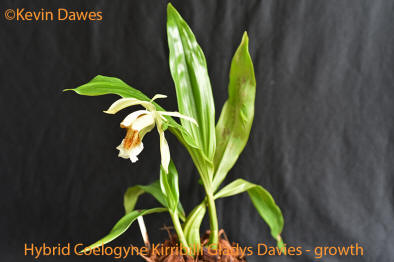Coelogyne Kirribilli Gladys Davies is a new (2017) primary Coelogyne hybrid plant.
When Coelogyne eberhardtii bloomed I was impressed with the attractive, upright and open style of the flowers and I experimented by cross pollinating it with some of my other orchids in flower at the time. It readily mated with Coelogyne speciosa and Coelogyne usitana (both closely related) but also with Coelogyne cristata and an existing hybrid, Coelogyne Memoria W. Micholitz. The impressive trait that is has passed on is the openness if the flower - a trait lacking in many Coelogyne species and consequently in many Coelogyne hybrids. Because many Coelogynes come from tropical high rainfall areas their flowers have evolved to act like umbrellas covering the breeding organs to minimise self fertilisation from the pollen washing down onto the stigma. This resulting pendulous, downward facing flowers lacks the attractive open and upward facing traits of other flowers.
In this hybrid I mated Coelogyne eberhardtii with an unusual variation of Coelogyne speciosa known informally as Coelogyne speciosa "Green". In Coelogyne speciosa there is an unusually large variation in flower colouring especially but in flower size, erectness or the degree to which the flowers are pendulous, the flowering size and length of flowering periods. Coelogyne speciosa "Green" has few flowers but they are particularly open, large and presented on long semi-erect spikes.
The flowers on Coelogyne speciosa "Green" are very pale and the "Green" label comes from the fact that its sepals and petals are distinctly light green rather than the more usual slightly muddy green/brown colouring.
Its traits have dominated almost completely over the pod parent. Coelogyne eberhardtii's shorter more numerous (5) irregular keels have been replaced by three very clear, well defined keels that run from the base of the hybrid very continuously well out onto the lip with the central keel being slightly smaller and finishing slightly sooner.
The whole of the inside lobes and extending well out onto the lip is an even, soft, almost speckled cinnamon colour which leaves the palest shadow on the outside of the lobes. Whilst Coelogyne eberhardtii has small patches of bright orange/brown/red colouring deep in the throat, there is only a tiny hint of colour along the central keel right at the base of the throat of the hybrid.
In the hybrid the typically narrow sepals stretch right back behind the flower, adding to its open appearance. The robust petals have a very strong mid-rib and they stretch backwards to 90 degrees from the light green column. While the dorsal petal leans forward in a traditional rain protecting position, it stands really well above the green column allowing good vision into the flower and provides a desirable openness.
The 90mm wide flower has one bud to open sequentially on a 150mm semi-erect spike growing from a developing psuedobulb. This spike manages to hold the large flower around mid-way between the rim of the pot and the top of the plant - a good effort inherited from the very erect Coelogyne eberhardtii.
This hybrid Coelogyne orchid was pollinated on 16.07.2010, deflasked on 16.09.2012 and produced its first flower on 28.12.2016 - nearly a six year project!
Negatives: .The bud on the spike of Coelogyne eberhardtii takes a long time to open. This is really only a problem for the impatient but new growers often fear that something may be wrong.
The parents are both from tropical areas (Vietnam and Thailand for the pod and PNG/Indonesia for the pollen parent) but in both cases the plants grow up to altitudes over 1000 feet. They like moisture and need protection from frost.
.Rating: ♦♦♦♦ This is a very attractive, bright, large, open flowering Coelogyne with an extremely beautiful pale colouring.
Registration: Registration with the RHS as Coelogyne Gladys Davies and was officially recorded in January 2017. It was named in memory of my wife's maternal grandmother - a loving and generous source of inspiration and leadership.
Varieties: There is a very pale version that is extremely attractive.
Hybrids: None registered
| < Coel Kirribilli Gillian | Coel Kirribilli Hubert > |

